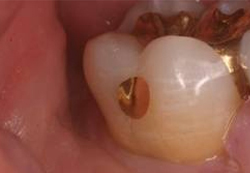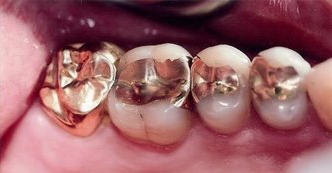Gold as restorative material
Types of Gold in Dentistry :
1. Pure gold (or) direct filling gold.
2. Cast gold – Gold alloy for restoration
3. Direct filling gold (or) gold foil
Introduction
History
Advantages and Disadvantages of gold foil
Indications and Contraindications for DFG
Types of gold foil
Cleaning / degassing / annealing of gold foil
Cavity preparation
Condensation of gold foil
Finishing and polishing of gold foil
Advantages of Direct Gold:
1. The direct gold restoration is the most permanent method of repairing the individual tooth. It can last as long as the tooth when properly placed.
2. It will not tarnish or corrode readily in oral cavity because of nobility.
3. Insoluble in oral of fluids and DFG has thermal expansion similar to that of dentin.
4. The cavity preparation when kept ideally small and exacting is atraumatic to the dentin and pulp and supporting structures.
5.Perfect adaptability to cavity walls. So the tooth discoloration will not occur and no microleakage (because of nobleness of gold).
6.The density and hardness of compacted gold enable the restoration to withstand compressive forces.
7. Gold develops good adaptation to the cavity walls no cementing medium is necessary for restoration.
8. Capability to take excellent polish.
9.Ductility of pure gold is excellent so this propety is useful in producing accurate margins for restoration.
10. Perfect weldability in cold stage.
11. Tensile strength: Gold is capable of holding weight of 7 tons/inch. So good edge strength.
12.Malleability: It exceeds all other metals in this respect. It can be reduced by beating to 1/250000†in thickness.
13.Softness during manipulation (this depends largely on purity)
14.Cohesiveness depends on purity.
15.Minimum tendency to flow and molecular change
16.The restoration procedure develops skill of operator
Disadvantages of Gold foil:
1.Inharmonious colour
2.Thermal conductivity is high. It can be a problem in a newly restored tooth.
3. Difficulty in Manipulation which is time consuming and requires meticulous steps and complete moisture control
4. Skill of dentist
INDICATIONS FOR DIRECT GOLD FOIL RESTORATION:
I. Incipient carious lesion:
The classes in the order in which direct golds are most commonly placed
Class I lesion in premolars teeth and other accessible developments pits
Small class III lesions in anterior teeth Class V gingival lesions.
Limited no. of inter proximal cavities. Class II mesial surface of molars.
Cuspal and mesial areas of all teeth
II Erosions : DFG is ideal for small eroded areas.
III Hypoplasia, white spots, defective pits, DFG is advocated in small pits, less conspicuous circular and irregular areas such as hypoplasia, white spots or defective pits, incisal edges cusp tips
IV Defective inlay margins, crown margins, and vents in the crown can be effectively repaired by DFG
CONTRAINDICATIONS FOR DFG:
-Inaccessible areas. DO cavities in molars
-Control of moisture is not possible.
-Large amount of tooth destruction
-Esthetics is of primary importance
-High occlusal stress
-Periodontally compromised tooth
-Old aged patient where he cannot withstand manipulative procedures
-Should never be used incomplete root formed teeth (because of force of condensation)
-Very young permanent teeth where pdl membrane is thick which will act as cushion for condensation DFG
-Physical condition and will power of patient mentality of patient
-Currently available products as gold foil type may be divided into 3 types with several subcategories (with 2 exceptions, they are 99.99 or higher purity)
Classification or types of gold foil:
I a) Foil
Cohesive
Or sheet
Non cohesive
b) Ropes
c) Cylinders
d) Laminated
e) Platimised
II Electrolytic Precipitate:
Mat
Mat foil
Alloyed
III Powder
Electroloy and goldent
Clinical characteristics / Ideal properties of Direct filling Gold
-Insoluble in oral fluids.
-Perfect adaptability to cavity walls less microleakage.
-No tarnish and corrosion.
-Compressive strength is sufficient to withstand masticatory forces.
-Healthy for gingiva
-Capability for excellent polishing and finishing
-Removal of surface impurities:
Two methods are used
Alcohol flaming
Electric annealer
Temperature required for annealing is above 6000F or 3150C
Heating the foiler pellet immediately before it is carried into the prepared cavity.
Heat treatment or annealing
The purpose of heat treatment in case of DFGs  –
1. Removal of amonia gases
2. Removal of sulphur and phosphorus
3. Removal of oxides on the surface
Nowadays the term degassing or desorbing is used
It can be done by piece method or bulk method
PIECE METHOD:
This is most practical method of annealing for all the types of DFG. It is done by using 90% ethyl alcohol lamp which is acetone free to avoid possible contaminations from sources.
Gold foil is carried with nichrome wire or foil carrier. The foil is heated till it gets dull red colour.
Mat foil is just passed in flame as it is soft. In case of powdered gold it is held in flame until the indicator burns off and the gold appears dull red (as wax has to dissolve)
All the bulky pieces must be allowed to cool momentarily before placing in the cavity.


